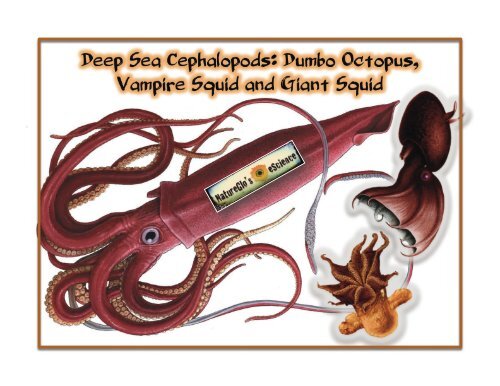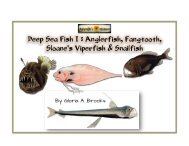You also want an ePaper? Increase the reach of your titles
YUMPU automatically turns print PDFs into web optimized ePapers that Google loves.
<strong>Deep</strong> <strong>Sea</strong> <strong>Cephalopods</strong>: Dumbo Octopus,<br />
Vampire Squid and Giant Squid
Natureglo’s eScience Copyright 2016<br />
Revised 9/15/17<br />
Permission is granted to reproduce this PowerPoint per student in a one family household, per<br />
student & teacher in one teacher’s classroom and for the purchaser’s personal use only. Thank<br />
you. Please notify me at gab21921@gmail.com for other circumstances. Thank you.<br />
Cover – Vintage images of a Giant squid (left), a Vampire squid (upper right) and Dumbo<br />
octopus (lower right). Images in the public domain.<br />
All other images used in this PowerPoint are either creative commons or public domain<br />
images.<br />
A vintage image of a deep sea octopus.<br />
Image in the public domain.
The Dumbo Octopus
Family Grimpoteuthis The Dumbo Octopus<br />
• Pelagic (open sea), deep sea<br />
umbrella octopus genus<br />
• Prominent ear-like fins protrude<br />
from mantle above lateral eyes<br />
• Commonly nicknamed "Dumbo<br />
octopuses" or "Dumbo octopods”;<br />
• Ear-like fins resemble Walt<br />
Disney's Dumbo the flying<br />
elephant’s ears<br />
Dumbo octopus illustration by Amélie Onzon.
The Dumbo Octopuses:<br />
Species Recognized, Variations & Knowledge About<br />
• At least 13<br />
species<br />
recognized; all<br />
different aspects<br />
• Differing species<br />
features – ear sizes,<br />
different colors<br />
• Most species poorly<br />
known; increasing research<br />
occurring with NOAA &<br />
MBARI deep sea<br />
expeditions<br />
Image credit: NOAA – “This tiny octopus, whose body measured about five centimeters across, was spotted swimming along at a depth of<br />
825 meters as we explored Whiting <strong>Sea</strong>mount on April 29, 2015, off the coast of Puerto Rico.” NOAA
Dumbo Octopus Abyssal<br />
Depths & Size<br />
• Living at extreme bathyl<br />
depths of 3,000 to 4,000<br />
meters (9,800 to 13,100 ft.);<br />
some living at 7,000 meters<br />
(23,000 ft.) below sea level,<br />
deepest of any known octopus<br />
• Some of rarest known<br />
Octopoda species<br />
A Dumbo octopus. Species<br />
unknown. A publicly used image.
• Geographic<br />
distribution –<br />
worldwide waters<br />
• Largest ever recorded –<br />
length: 1.8 meters (5.9<br />
ft.); weight: 5.9<br />
kilograms (13 lb.)<br />
• Average size for most<br />
species – length: 20–30<br />
centimeters (7.9–12 in)<br />
Dumbo Octopus<br />
Geographic Range & Size<br />
“This rare Dumbo octopus (Cirrothauma<br />
murrayi) is often called the Blind Octopod due<br />
to the lack of a lens and retina in its eyes. Its<br />
eyes can only detect light and cannot form<br />
images.” Quote & image credit: NOAA
Dumbo Octopus Movement & Diet<br />
• Swimming – ear-like fin flaps propel body upwards with arm<br />
movement moving directionally<br />
• Arms permit crawling along seafloor<br />
• Diet - polychaete worms, pelagic copepods, isopods,<br />
amphipods, and other crustaceans for food<br />
• Prey capture - pounce on target, then swallow it whole<br />
Grimpo Megaptera 1885<br />
a public domain image.<br />
Grimpo hippocrepium<br />
by Hoyle 1904. Image<br />
in the public domain.
Image credit: Sitron CC BY-SA 3.0
The Vampire Squid<br />
Vampyroteuthis infernalis<br />
• Small, deep-sea cephalopod<br />
found throughout temperate<br />
& tropical oceans worldwide<br />
• Cloak-like webbing, red eyes<br />
give Vampire squid its name;<br />
doesn’t feed on blood<br />
• Colors – velvety brown, jet<br />
black, red<br />
Images – Both of same Vampire<br />
squid, A vintage image in the public<br />
domain.
Vampire Squid Classification<br />
• 1903 - first described & classified by German<br />
teuthologist, Carl Chun<br />
• Only known surviving member of its order,<br />
Vampyromorphida
Vampire Squid Description<br />
• Length - 30 cm (1 ft.), 15-cm<br />
(6-in.) gelatinous body<br />
• Skin webbing connects 8<br />
arms, each lined with rows of<br />
fleshy spines or cirri<br />
• Black inner "cloak”<br />
Background image – oral side of a<br />
Vampire squid. Image. In the public<br />
domain.
Vampire Squid – Eyes & Webbing<br />
• Large globular eyes, appear red or blue; proportionately largest in animal<br />
kingdom at 2.5 cm (0.98 in) in diameter<br />
• Within webbing, two pouches house concealed long filaments (thread-like)<br />
instead of tentacles; extend past arms for prey capture
Vampire Squid Bioluminescence<br />
• What is bioluminescence?<br />
chemical light produced by<br />
living organisms including<br />
Vampire squid<br />
Vampire squid photophores:<br />
• Photophores definition – light<br />
producing organs<br />
• Almost entirely cover its body<br />
• Produce light flashes from<br />
seconds to several minutes<br />
• Photoreceptors – 2 larger, white<br />
areas on top of head; absent from<br />
caped underside<br />
A Vampire squid’s photophores lit up.<br />
Image credit: Biological Bulletin.
Vampire Squid in Captivity & Diet<br />
• May 2014, Monterey Bay<br />
Aquarium (California,<br />
United States) – first to<br />
ever put species<br />
successfully on display<br />
• Filaments contact<br />
potential prey or if<br />
vibrations felt, inspect<br />
with rapid acrobatic<br />
movements<br />
A Vampire squid with its filament<br />
extended. Image credit: Monterey<br />
Bay Aquarium Institute.
Vampire Squid Prey & Predators<br />
• Diet – copepods, ostracods,<br />
amphipods, isopods; detritus:<br />
remains of gelatinous zooplankton<br />
(salps, larvaceans, medusae jellies)<br />
• Predators - deepwater fish: giant<br />
grenadiers & deep-diving mammals,<br />
whales & sea lions<br />
An ostrocod; image<br />
credit: Anna Syme.<br />
An isopod, Speckled sea<br />
louse from the Belgian<br />
coast, Europe. Image credit:<br />
Hans Hillewaert<br />
An amphipod. Image<br />
credit: Uwe Kils.
V<br />
A<br />
M<br />
P<br />
I<br />
R<br />
E<br />
• Low metabolic rate & weak muscles limit stamina<br />
• Bioluminescent "fireworks” combined with glowing<br />
writhing arms, erratic movements, and escape<br />
trajectories = difficulty for predators to identify it<br />
• Threat posture – called "pumpkin" or "pineapple”:<br />
inverts caped arms back over body; creates larger<br />
looking form covered in fearsome-looking but<br />
harmless spines (called cirri)<br />
D<br />
E<br />
F<br />
E<br />
N<br />
S<br />
S<br />
Q<br />
U<br />
I<br />
d<br />
E<br />
s<br />
The inside-out “pumpkin”<br />
or pineapple defense<br />
posture of a Vampire<br />
squid. Image credit: MBARI.
Family Architeuthidae - The Giant Squid
Giant Squid Architeuthis dux<br />
• <strong>Deep</strong>-ocean dwelling squid<br />
• Grow to tremendous size due to deep-sea gigantism; females:<br />
13 m (43 ft.); males: 10 m (33 ft.) from posterior fins to two<br />
long tentacles tips<br />
• Second largest invertebrate after Colossal squid<br />
Mesonychoteuthis hamiltoni growing up to 46 ft.<br />
• 2004 Japanese researchers took first images of live specimen<br />
in natural habitat<br />
• July 2012 - live adult first filmed in natural habitat off Chichijima,<br />
Japan<br />
A Colossal squid illustration. Image in the public domain.
Giant Squid Anatomy<br />
• 3 Main body parts - mantle (torso), 8 arms, and 2 longer tentacles (longest known<br />
cephalopod tentacles<br />
• Inside surfaces of arms & tentacles lined with hundreds of subspherical suction<br />
cups, 2 - 5 cm (0.79 to 1.97 in) in diameter, each mounted on a stalk<br />
• Suckers circumference lined with sharp, finely serrated chitin rings<br />
• Common to find circular sucker scars on or close to sperm whales head that have<br />
attacked or been attacked by giant squid<br />
Background<br />
image – <strong>Sea</strong><br />
water off the<br />
coast of Italy.<br />
Image in the<br />
public domain.<br />
Image credit: Smithsonian Institution
Images credit: Smithsonian Institution<br />
A Giant squid’s beak.
Three arm and tentacle regions:<br />
• Carpus ("wrist”) – dense cups<br />
cluster, in 6 or 7 irregular,<br />
transverse rows<br />
• Manus ("hand") – broader, close<br />
to arm end with enlarged suckers<br />
in 2 medial rows<br />
• Dactylus ("finger”) - the tip; arm<br />
bases & tentacles arranged<br />
circularly surrounding animal's<br />
single, parrot-like beak, like<br />
other cephalopods<br />
Image – Giant squid vintage image showing the<br />
entire body, tentacles and other body parts.<br />
Image in the public domain.
A close-up of a Giant squid’s club tentacle detail.<br />
Image in the public domain.
References<br />
1. Piper, R. (2007). Extraordinary Animals: An<br />
Encyclopedia of Curious and Unusual Animals.<br />
Greenwood Press.<br />
2. Eyden, P. (2004) Cretaceous Giant Squid. The Octopus<br />
News Magazine Online.<br />
3. Tanabe, K., Hikida, Y. & Iba, Y. (2006). "Two coleoid jaws<br />
from the Upper Cretaceous of Hokkaido, Japan". Journal<br />
of Paleontology 80: 138–145. doi:<br />
10.1666/0022-3360(2006)080[0138:TCJFTU]2.0.CO;<br />
2.<br />
4. Teichert, C. & B. Kümmel (1960). "Size of Endocerid<br />
<strong>Cephalopods</strong>". Breviora Mus. Comp. Zool. 128: 1–7.<br />
5. O'Shea, S. 2003. "Giant Squid and Colossal Squid Fact<br />
Sheet". The Octopus News Magazine Online.<br />
6. Wikipedia Giant squid article: https://en.wikipedia.org/<br />
wiki/Giant_squid<br />
Image – A Vampire squid among marine<br />
snow. Image credit: Open Exploration Trust.
Thank<br />
you for<br />
watching!<br />
A vintage image of an Umbrella squid.<br />
Image in the public domain.











